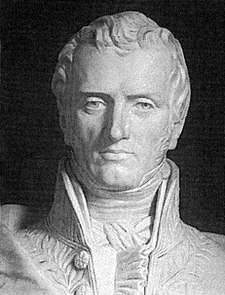Claude-Louis Navier
Claude-Louis Navier (born Claude Louis Marie Henri Navier; French: [klod lwi maʁi ɑ̃ʁi navje]; 10 February 1785 – 21 August 1836), was a French mechanical engineer, affiliated with the French government, and a physicist whose work was specialized in continuum mechanics.
Claude-Louis Navier | |
|---|---|
 Bust of Claude Louis Marie Henri Navier at the École Nationale des Ponts et Chaussées | |
| Born | Claude Louis Marie Henri Navier 10 February 1785 |
| Died | 21 August 1836 (aged 51) |
| Nationality | French |
| Alma mater | École Nationale des Ponts et Chaussées |
| Known for | Navier–Stokes equations |
| Scientific career | |
| Fields | Mathematical physics |
| Institutions | École Nationale des Ponts et Chaussées École polytechnique French Academy of Science |
| Academic advisors | Joseph Fourier |
The Navier–Stokes equations are named after him and George Gabriel Stokes.
Biography
After the death of his father in 1793, Navier's mother left his education in the hands of his uncle Émiland Gauthey, an engineer with the Corps of Bridges and Roads (Corps des Ponts et Chaussées). In 1802, Navier enrolled at the École polytechnique, and in 1804 continued his studies at the École Nationale des Ponts et Chaussées, from which he graduated in 1806. He eventually succeeded his uncle as Inspecteur general at the Corps des Ponts et Chaussées.
He directed the construction of bridges at Choisy, Asnières and Argenteuil in the Department of the Seine, and built a footbridge to the Île de la Cité in Paris. His 1824 design for the Pont des Invalides failed to leave a safety margin on top of his calculations, and after cracking the bridge had to be dismantled, destroying Navier's bridge-building reputation. He was chastised by a government committee for relying too much on mathematics.[1]
In 1824, Navier was admitted into the French Academy of Science. In 1830, he took up a professorship at the École Nationale des Ponts et Chaussées, and in the following year succeeded exiled Augustin Louis Cauchy as professor of calculus and mechanics at the École polytechnique.
Contributions
Navier formulated the general theory of elasticity in a mathematically usable form (1821), making it available to the field of construction with sufficient accuracy for the first time. In 1819 he succeeded in determining the zero line of mechanical stress, finally correcting Galileo Galilei's incorrect results, and in 1826 he established the elastic modulus as a property of materials independent of the second moment of area. Navier is therefore often considered to be the founder of modern structural analysis.
His major contribution however remains the Navier–Stokes equations (1822), central to fluid mechanics.
His name is one of the 72 names inscribed on the Eiffel Tower.
External links
- O'Connor, John J.; Robertson, Edmund F., "Claude-Louis Navier", MacTutor History of Mathematics archive, University of St Andrews.